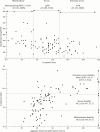Sensorimotor changes and functional performance in patients with knee osteoarthritis
- PMID: 9462165
- PMCID: PMC1752287
- DOI: 10.1136/ard.56.11.641
Sensorimotor changes and functional performance in patients with knee osteoarthritis
Abstract
Objective: Muscles are essential components of our sensorimotor system that help maintain balance and perform a smooth gait, but it is unclear whether arthritic damage adversely affects muscle sensorimotor function. Quadriceps sensorimotor function in patients with knee osteoarthritis (OA) was investigated, and whether these changes were associated with impairment of functional performance.
Methods: Quadriceps strength, voluntary activation, and proprioceptive acuity (joint position sense acuity) were assessed in 103 patients with knee OA and compared with 25 healthy control subjects. In addition, their postural stability, objective functional performance (the aggregate time for four activities of daily living), and disabilities (lequesne index) were also investigated.
Results: Compared with the control subjects, the patients with knee OA had weaker quadriceps (differences between group mean 100N, CI 136, 63N), poorer voluntary activation (20% CI 13, 25%) that was associated with quadriceps weakness, and impaired acuity of knee joint position sense (1.28 degrees, CI 0.84, 1.73 degrees). As a group the patients were more unstable (p = 0.0017), disabled (10, CI 7, 11), and had poorer functional performance (19.6 seconds, CI 14.3, 24.9 seconds). The most important predictors of disability were objective functional performance and quadriceps strength.
Conclusions: In patients with knee OA, articular damage may reduce quadriceps motoneurone excitability, which decreases voluntary quadriceps activation thus contributing to quadriceps weakness, and diminishes proprioceptive acuity. The arthrogenic impairment in quadriceps sensorimotor function and decreased postural stability was associated with reduced functional performance of the patients.
Figures



References
Publication types
MeSH terms
LinkOut - more resources
Full Text Sources
Medical
Research Materials

